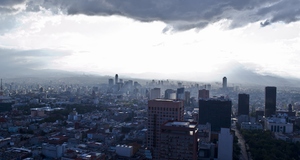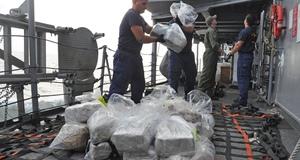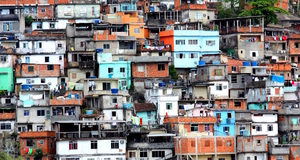From Clocks and Clouds VOL. 6 NO. 2Rationally Irrational: Applying the Rational Actor Model to Rio De Janeiro's Police-Gang ConflictFurthermore, the gang embodies an internal culture of risk which makes individuals within it more susceptible to engaging in violence. The majority of people who join gangs are in the demographic of young men (1519) of color with low socioeconomic status (Fernandes 2013). Furthermore, Brazil has one of the highest homicide rates in the world (at 25.2/100,000 inhabitants), and 89.8 percent of those homicides are men (United Nations Office on Drugs and Crime 2013). The average number of youth homicides (ages 14-19) in Rio reaches 289/100,000 inhabitants, 70 percent of these related to "drug trafficking and other related conflicts" (Zaluar 2012, 15). The life expectancy for most of the young men who join gangs is low, and they recognize this as they join; these individuals often see their life paths as a trade-off between being wealthy and being guaranteed a long life. The "nothing-to-lose" mentality that comes from poverty and short life expectancy means that these young men will be more likely to engage in conflict and risky behavior (Aranha 2012). Additionally, Zaluar (2012, 20) finds in her study that the favela harbors a culture of hyper-masculinity, in which carrying a firearm is seen as a sign of manliness and those who join a gang succeed in providing themselves protection in the local conflict; if one doesn't join the gang, he risks being attacked by both sides within this conflict. The "enlistment" strategy of favela gangs, therefore, appears to be one which capitalizes on the vulnerability of young men in poverty. Violence and mistreatment from the police also motivate favela residents to organize against the police and align with gangs (Rodrigues and Endelmond 2014), which means that those joining the gang likely agree with the political conflict the gang engages in. A community organizer of the favela Rocinha said: "Before, a child could walk alone in the street without fear. Today, that's impossible. We just don't understand how this situation is possible considering that, since the ‘pacification' of the favela, there are now policemen everywhere" (Rodrigues and Endelmond 2014). A communal mistrust of the police therefore aligns the favela as a whole against the police and likely leads to the recruitment of more gang members. This is characteristic of Kaldor's (1999) idea of new wars, in that the favela gang attracts new members by identifying with a common struggle of inequality and failure of the government. This communal mistrust of the police is not only a shared experience within the favela, but one that has been popularized in the music genre of Brazilian funk, largely popular within favelas. The widely popular funk song "Rap da Felicidade (Eu Só Quero É Ser Feliz)" (translating to "Rap of Happiness (I Just Want to Be Happy)"), for example, conveys the sentiment which many people living within the favela share: Fun today, we can't even think about it This rhetoric emphasizes the state's role in bringing insecurity to the favela. This song also shows how a political fight against the police and state has become part of the social culture of the favela in two identifiable ways. First, it refers to frustration from police monitoring of baile funks, or favela-organized parties which serve as the primary social event for young people within the favela, which shows how omni-present the police has become in monitoring all aspects of occupied favela life. Furthermore, this song contains a deliberate call for action at the end of this excerpt, in which people create their own protection without a need for the police or the state. The artist of this highly popular song (Cidinho e Doca) seems to urge favela residents to identify as from the favela before identifying as from Brazil in a more general sense, and to organize and fight for their own interests within the favela whether the government will help them or not. The inclusion of anti-government (and, thus, pro-gang) political values in spheres of favela youth pleasure works to incorporate the gang as defending a collective, imagined "us." It also makes the imagined experience of living in the favela synonymous with a struggle against the police. In this struggle, favela gangs do not only provide material protection for their favela communities, but social protection, as well. Government neglect and police brutality are a part of favela gangs' motivation and organization, in that favela gangs often provide the social services that the state does not due to historical gang ideology. Glenny (2015) reports from an interview that Nem, the gang leader of Rocinha, provided an integral role as, in effect, mayor, police chief and director of the chamber of commerce for a community estimated at 100,000 residents… ‘The food baskets and the support we gave to extracurricular school activities, such as the Thai boxing or capoeira classes, were all accounted for as part of our business expenses,' [Nem] explained. ‘But the burials, prescription costs or if anyone who couldn't afford it needed gas, these were all extra payments.' Favela gangs thus fulfill governmental roles within the favela and flexibly respond to the needs of their communities. This is an inheritance of the communist nature of super-gangs like the Comando Vermelho (Red Command) of the 1980s, a group which formed alliances between common criminals and communists who were imprisoned at the same time by the military dictatorship. The political prisoners inspired criminals to politicize their work, creating a gang that had both criminal and political knowledge and strategies ("Red Command"). The communist nature of this powerful gang has meant that part of the inherited identity and motivation of today's gangs is taking care of their communities and providing services (Ramos 2013). Through gangs' support of their communities, more favela residents are sympathetic with gangs, and gangs also become legitimized within society by taking altruistic action; gang motivation to provide for their communities thus becomes part of their strategy in the conflict, as well. Furthermore, favela gangs have a degree of uncertainty in just how far the UPP will go in this conflict. Different units within the government's initiative for the UPP and its associated parts have taken significantly varied approaches; the BOPE is extremely violent, the UPP police are less violent (but still use forceful tactics), and the UPP Social organize social programs to help the communities. The way that a gang responds, therefore, is specific to the unit that it is dealing with. A drug dealer, in an interview with Pardo and Inzunza (2014), explained, "‘When the police come, we give them something. When the BOPE comes… we have to escape.'" Part of this reactive strategy is to hire fogueteiros, or lookouts who set off firecrackers or other signals to announce the arrival of the police (Pardo and Inzunza 2014). Gangs have to improvise their reaction to the arrival of the UPP based off of which specific unit it is dealing with, and even then gang members may not know how violent or demanding the individuals within the approaching police unit may be. The previous knowledge that gang members may have on certain individuals or divisions of the police is critical to gang response and strategy. Therefore, it appears that the motivation and strategy of favela gangs in this conflict are inextricably linked, in that they adopt their strategy from their historical and current motivations and are always responsive to whatever circumstances they are facing. Gang members take care of their community because it is part of their credence, and gain more supporters and legitimacy in the process; they fight against the police's attempt to restrict the drug trade and are able to finance this fight through the money gained through trafficking; and are motivated to fight due to their frustration with the police and state government, which also fuels community support and more recruits. We can understand the favela gangs' involvement in this conflict as mobilizing all of their available resources to defend their economic livelihoods, simultaneously using economic, cultural and social tools to gain weapons, popular support and members. ConclusionThrough this analysis, we see the rational motivations and strategies behind the involvement of both the government and gangs in Rio's civil conflict. Although this conflict seems to have an obvious outcome (favela gangs will never realistically have enough power to overcome the power of the state), the motivating factors behind each actor provoke each side to act in the way it does. Favela gang members are primarily fighting to maintain their incomes, whereas the state government is fighting to create the city of its imaginary and influence favela residents and gangs into recognizing the state's authority. Though the state government has a much higher chance of winning this conflict because of its material power, the stakes are much greater for favela gangs, as their livelihoods are threatened by state occupation. Furthermore, the state government is quite unclear in its intentions within the favela; although it says that it is not attempting to stop drug trafficking within the favela in engaging in this conflict, part of its explicit strategy is to demobilize the most powerful actors in drug trafficking before it occupies the area with a UPP unit. It seems that the government is mostly out to "make an example" out of the individuals who had demonstrated to the rest of the community that they were working above the powers of the state. As these are usually the individuals responsible for organizing the gang's social services to the community – such as the head drug-dealer of Rocinha, Nem – the government relays its message not only to gangs but to the general favela community in going after powerful gang figures. The government's strategy implies that it is attempting to obtain control through inspiring fear, both in hunting individuals in the way I just described and through excessively violent tactics that are sometimes directed at residents. These coercive tactics are a powerful way of showing the entire favela community that the state has arrived to the favela and will be taking control. Again, it is important to emphasize that the state has only mobilized such programs in favelas that have the potential to affect the populations that the state prioritizes (which is wealthy and tourist). However, the government simply fuels the fire of opposition from favela gangs and residents through this strategy. As we can see in the cultural popularization of messages against police brutality in funk music, some favela residents feel that they were better off without the occupying presence of the state, which often makes them favor favela gangs. A decline in government support also opens up a wealth of resources to favela gangs; since gangs are fighting on their own turf, those who side with favela gangs are likely to provide resources like membership or use of space, among other potentially valuable capital. The government's strategy has therefore weakened its resources and popular support by treating favela residents with coercion instead of inclusion and integration. If the government does not adjust its strategy, it may have to confront the consequences of a neglected, ostracized, angry favela population in the future, in an even more violent conflict. The current gang/police conflict has so far only served to push violence into poorer areas, which is contributing to the further development of two distinct Rio de Janeiros (wealthy and poor) within the city limits. According to Kaldor's theory of new wars, inequality leads to conflict, which means that the Rio government may face more conflict in the future if it continues to contribute to perpetuated inequality. Therefore, the Rio government should seek out meaningful alternative strategies and motivations in this conflict to truly secure sustainable progress away from societal violence. For instance, if the state government were to shift its motivations towards creating a more equitable climate within the favela and in Rio in general, we would see an enormous change in its strategy for taking back the monopoly of violence. As the conflict currently stands, the government is not working for sustainable progress and appears to believe that perpetual fighting and occupation are more strategic to its priorities than seeking out ways to eradicate the conditions that created violence within favelas in the first place. AuthorAmber Waltz was a student of International Studies She graduated in December of 2015. School of International Service (SIS), American University. ReferencesAllison, Graham T. and Philip Zelikow. 1999. Essence of Decision: Explaining the Cuban Missile Crisis. New York: Addison-Welsey Educational Publishers. Aranha, Ana. 2012. "Escaping Brazil's Drug Gangs." Panos Network, June 25. http://www. panosnetwork.org/features/27-escaping-sao-paulo-s-drug-gangs. Arias, Enrique Desmond. 2006. "The Dynamics of Criminal Governance: Networks and Social Order in Rio De Janeiro.".Journal of Latin American Studies 38, no. 2: 293–325. Arias, Enrique Desmond, and Corinne Davis Rodrigues. 2006. "The Myth of Personal Security: Criminal Gangs, Dispute Resolution, and Identity in Rio De Janeiro's Favelas". Latin American Politics and Society 48, no. 4: 53–81. Bargent, James. 2015. "Seizures of High-Powered Weapons on the Rise in Rio de Janeiro." InSight Crime, March 12. http://www.insightcrime.org/news-briefs/seizures-high-poweredweaponsrise-rio-de-janeiro. "BOPE." BOPE. Accessed December 6th, 2015. http://www.bopeoficial.com/. "News." BOPE. Accessed December 6th, 2015. http://www.bopeoficial.com/categoria/news/. Cidinho e Doca. 1994. "Eu Só Quero É Ser Feliz." Rap Brasil. https://letras.mus.br/rapbrasil/564946/. Coutinho, Davison. 2015. "Mais Uma Noite de Violencia na Rocinha. Moradores Questionam Papel da UPP." Jornal do Brasil, August 21. http://www.jb.com.br/comunidade-empauta/noticias/2015/08/21/mais-uma-noite-de-violencia-na-rocinha-moradoresquestionampapel-da-upp/. dos Santos, Júlio César Borges. "Os megaeventos, a política de pacificação e a transformação da favela em commoditie." http://megaeventos.ettern.ippur.ufrj.br/sites/default/files/artigos-cientificos/santos_j._a_politica_de_pacificacao_e_a_transformacao_da_favela_em_commoditie.pdf. "Em 2015, 571 pessoas foram mortas em operações policiais em São Paulo." 2015. O Globo, September 21. http://g1.globo.com/sao-paulo/noticia/2015/09/em-2015-571-forammortasem-operacoes-policiais-em-sao-paulo.html. Fernandes, Fernando Lannes. 2013. "Youth Gang Members in Rio de Janeiro: The Face of a ‘Lost Generation' in an Age of Fear and Mistrust." Bulletin of Latin American Research 32, no. 2: 210-223. Fischer, Brodwyn M. 2008. A poverty of rights: citizenship and inequality in Twentieth-Century Rio de Janeiro. Stanford: Stanford University Press. Glenny, Misha. 2015. "The Day I Met Rio's Favela Master: The Drug Lord Who Championed the Poor." The Observer, September 19. http://www.theguardian.com/world/2015/sep/13/rio-favel-master-nem-of-rocinha-drug-lord-champion-of-the-poor. Hagedorn, John M. 1999. "Street Institutions: Why Some Gangs Won't Go Away," A World of Gangs: Armed Young Men and Gangsta Culture. Minneapolis: University of Minneapolis. Henriques, Ricardo and Silvia Ramos. "Social UPPs: social actions for the consolidation of pacification." Federal University of Rio de Janeiro. http://www.ie.ufrj.br/datacenterie/pdfs/seminarios/pesquisa/texto3008.pdf. Holston, James. 2008. Insurgent Citizenship: Disjunctions of democracy and modernity in Brazil. Princeton: Princeton University Press. Kaldor, Mary. 1999. "Introduction." In New and Old Wars: Organized Violence in a Global Era. Stanford: Stanford University Press. Levy, Jack S., and William R. Thompson. 2011. Causes of war. Hoboken: John Wiley & Sons. Monken, Mario. 2012. "Os negócios ilegais de PMs no Rio: venda de armas e drogas ao tráfico." Ultimo Segundo, May 30. http://ultimosegundo.ig.com.br/brasil/rj/2012-05-30/osnegociosilegais-de-pms-no-rio-venda-de-armas-e-drogas-ao-tra.html. Morro dos Prazeres. 2013. Directed by Maria Augusta Ramos. Rio de Janeiro: Nofoco Filmes Producoes Cinematografias. Pardo, Jose Luis and Alejandra S. Inzunza. 2014. "Inside the Cracklands of Rio de Janeiro's Favelas." InSight Crime, August 11. http://www.insightcrime.org/news-analysis/inside-the-cracklands-of-rio-de-janeiros-favelas. "Perguntas Frequentes." UPP. Accessed December 6th, 2015. http://www.upprj.com/index.php/faq. "Photos." UPP. Accessed on December 6th, 2015. http://www.upprj.com/. "PM vai montar 17 pontos de bloqueio a ônibus nos acessos às praias do Rio." 2011. O Globo, September 25. http://g1.globo.com/rio-de-janeiro/noticia/2015/09/pm-vai-montar17-pontos-de-bloqueio-onibus-nos-acessos-praias-do-rio.html. Pretteceille, Edmond and Licia Valladares. "A desigualdade entre os pobres — favela, favelas." In Desigualdade e Pobreza no Brasil, edited by Ricardo Henriques, 459-485. Rio de Janeiro: IPEA, 2000. "Red Command." InSight Crime. http://www.insightcrime.org/brazil-organized-crime-news/red-command-profile. Rodrigues, Fabiana and Stephanie François-Endelmond. 2014. "‘My favela was safer when it was ruled by gangs.'" France 24, November 18. http://observers.france24.com/en/20141118-favela-rio-gangs-safety-rocinha. van Dijk, Teun A. 1993. "Principles of Critical Discourse Analysis" Discourse & Society 4(2): 249-83. Vigna, Anne. "UPP Leva Violencia Para Escola no Alemao." 2015. Brasil 24/7, November 30th. http://www.brasil247.com/pt/247/favela247/207392/UPP-leva-viol%C3%AAnciaparaescola-no-Alem%C3%A3o.htm. Wolff, M. J. 2015. "Building Criminal Authority: A Comparative Analysis of Drug Gangs in Rio de Janeiro and Recife." Latin American Politics and Society 57: 21–40. Zaluar, Alba. 2012. "Youth, Drug Trafficking and Hyper-masculinity in Rio de Janeiro." Vibrant 7, no. 2: 7-27. Suggested Reading from Inquiries Journal
Inquiries Journal provides undergraduate and graduate students around the world a platform for the wide dissemination of academic work over a range of core disciplines. Representing the work of students from hundreds of institutions around the globe, Inquiries Journal's large database of academic articles is completely free. Learn more | Blog | Submit Latest in Political Science |



















